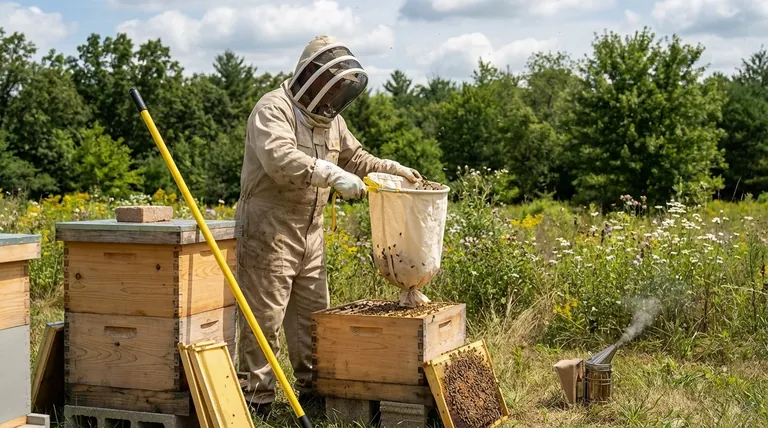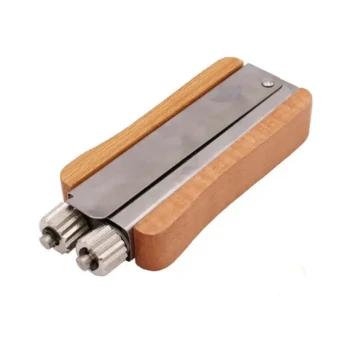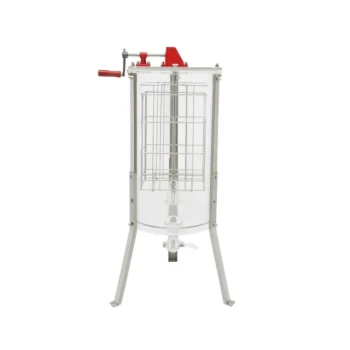An artificial swarm is a beekeeping management technique where a beekeeper intentionally splits one colony into two. This is done primarily to control the colony's natural swarming impulse, but it serves as a highly effective, non-chemical method for reducing Varroa mite populations by breaking their reproductive cycle.
The core challenge in fighting Varroa mites is their rapid reproduction within sealed bee brood. An artificial swarm works by creating a strategic "brood break"—a temporary period with no sealed brood—which starves the mites of their ability to multiply and dramatically lowers their numbers.

The Underlying Problem: The Varroa Mite Lifecycle
How Varroa Mites Reproduce
Varroa destructor mites are parasites that require honey bee brood (developing larvae and pupae) to reproduce. A female mite enters a brood cell just before it is capped, lays her eggs, and her offspring feed on the developing bee.
The Power of an Unbroken Brood Cycle
In a healthy, continuously laying colony, mites have a constant supply of brood cells to invade. This allows their population to grow exponentially, eventually overwhelming and killing the colony if left unchecked.
Deconstructing the Artificial Swarm
Mimicking a Natural Swarm
When a colony swarms naturally, the old queen and a portion of the bees leave the hive. This exodus carries a percentage of the phoretic mites (those riding on adult bees) with it, reducing the original colony's mite load by up to 20%.
Creating a Critical "Brood Break"
The true power of an artificial swarm lies in creating a broodless period. By manipulating the colony, the beekeeper creates a situation where the queen has nowhere to lay eggs for a short time, or the new colony must raise a new queen, which takes about three weeks.
The Mechanics of the Split
The process involves moving the queen and flying bees to a new hive box on the original site, leaving the brood (and the mites within it) in the original box, which is moved elsewhere. The queen-right portion becomes broodless for a period, halting mite reproduction within it.
Understanding the Trade-offs
It Is a Management Technique, Not Eradication
An artificial swarm significantly reduces the mite population but does not eliminate it entirely. It is a powerful tool for control as part of an Integrated Pest Management (IPM) strategy.
Timing and Skill Are Essential
This is not a passive technique. It requires a good understanding of bee biology and colony management. Performing the split at the wrong time or incorrectly can stress the colony and potentially impact its productivity.
Potential Impact on Honey Production
Splitting a strong colony during a nectar flow can temporarily reduce the foraging workforce. This may result in a smaller honey harvest from that specific colony for the season, a common trade-off for ensuring long-term colony health.
A Note on Hive Design and Mite Control
Natural Cell Size in Top Bar Hives
Some hive designs, like top bar hives, allow bees to build their own comb to a natural, smaller cell size. The references suggest this tight fit can disrupt or kill developing Varroa mites due to lack of space.
Larger Cells in Langstroth Hives
In contrast, standard Langstroth hives use foundation with a pre-determined, often larger, cell size. This larger space may inadvertently create a more favorable environment for mites to reproduce successfully.
Making the Right Choice for Your Apiary
Ultimately, your approach depends on your goals and beekeeping philosophy.
- If your primary focus is aggressive, non-chemical mite reduction: An artificial swarm is one of the most effective mechanical controls you can use to reset mite populations.
- If your primary focus is a more passive, preventative strategy: Consider hive types and foundation sizes that encourage natural bee behavior and may create a less hospitable environment for mites.
- If you are new to beekeeping: Study the detailed procedures from expert sources, like the National Bee Unit, before attempting an artificial swarm to ensure you do it correctly.
By understanding and interrupting the Varroa mite's life cycle, you can take decisive control over the health and survival of your colonies.
Summary Table:
| Aspect | Key Takeaway |
|---|---|
| Primary Goal | Control swarming & reduce Varroa mite populations. |
| Core Mechanism | Creates a 'brood break' to starve mites of reproduction sites. |
| Effectiveness | Significant mite population reduction; part of an IPM strategy. |
| Best For | Beekeepers seeking aggressive, non-chemical mite control. |
| Consideration | Requires skill & timing; can temporarily impact honey production. |
Ready to implement effective Varroa mite control in your apiary?
As a trusted wholesale supplier to commercial apiaries and equipment distributors, HONESTBEE provides the durable tools and equipment you need to successfully perform techniques like artificial swarming. Our products are designed to support the health and productivity of your operations.
Contact our expert team today to discuss how our beekeeping supplies can strengthen your Integrated Pest Management (IPM) strategy.
Visual Guide

Related Products
- HONESTBEE Professional Telescopic Pole Bee Swarm Catcher
- HONESTBEE Advanced Ergonomic Stainless Steel Hive Tool for Beekeeping
- HONESTBEE Durable Ergonomic Wooden Handle Frame Wire Crimper
- HONESTBEE 2 Frame Manual Acrylic Honey Extractor Beekeeping Equipment
- Adjustable Stainless Steel Honey Uncapping Fork with Scraper for Beekeeping
People Also Ask
- How frequently should pollen be harvested from the traps? Ensure Optimal Hive Health & Superior Quality
- How do beekeepers catch bees? Master Swarm Capture for Apiary Success
- Do honey bees leave their hives? Understanding the Critical Role of Swarming
- What precautions can be taken to prevent a newly captured swarm from absconding? Secure Your Swarm with Proven Methods
- How should a captured swarm be placed into the hive equipment? A Guide to Secure Hiving



















